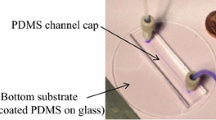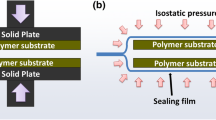Abstract
Parylene microfluidic systems have been utilized for applications requiring properties such as high chemical resistance, high internal pressure, high mechanical strength, and small heat loss. However, they have not been widely used compared to PDMS microfluidics because the device fabrication is relatively complex and surface functionalization is difficult. In this work, we introduce a simple and economic fabrication method for parylene microfluidic devices by molding and bonding using thin-film parylene A as an adhesive layer. The amine functional group from parylene A leverages as a covalent bonding source in between two parylene layers while providing the capability of functionalization of the internal surface of parylene microfluidic channel that is highly resistant to harsh chemicals at the same time. This new approach demonstrates the ability of high bonding strength (~ 4 Mpa) and eliminates the use of an additional adhesive polymer layer, which often fails to provide sufficient chemical resistance.




Similar content being viewed by others
References
Jähnisch, K., Hessel, V., Löwe, H., Baerns, M.: Chemistry in microstructured reactors. Angew. Chem. Int. Ed. 43(4), 406–446 (2004)
Alrifaiy, A., Lindahl, O.A., Ramser, K.: Polymer-based microfluidic devices for pharmacy, biology and tissue engineering. Polymers 4(3), 1349–1398 (2012)
Koch, M., Evans, A., Brunnschweiler, A., Evans, A., Brunnschweiler, A.: Microfluidic technology and applications. Research Studies Press Baldock. (2000)
Becker, H., Locascio, L.E.: Polymer microfluidic devices. Talanta 56(2), 267–287 (2002)
Omasu, F., Nakano, Y., Ichiki, T.: Measurement of the electrophoretic mobility of sheep erythrocytes using microcapillary chips. Electrophoresis 26(6), 1163–1167 (2005)
Kim, J.-O., Kim, H., Ko, D.-H., Min, K.-I., Park, S.-Y., Kim, D.-P.: A monolithic and flexible fluoropolymer film microreactor for organic synthesis applications. Lab Chip 14(21), 4270–4276 (2014)
Szymborski, T., Jankowski, P., Garstecki, P.: Teflon microreactors for organic syntheses. Sens. Actuators, B Chem. 255, 2274–2281 (2018)
Kim, B.J., Meng, E.: Micromachining of Parylene C for bioMEMS. Polym. Adv. Technol. 27(5), 564–576 (2016)
Kim, J., You, J.B., Nam, S.M., Seo, S., Im, S.G., Lee, W.: Rollable microfluidic systems with microscale bending radius and tuning of device function with reconfigurable 3D channel geometry. ACS Appl. Mater. Interfaces. 9(12), 11156–11166 (2017)
Jung, B.-J., Kim, J., Kim, J.-A., Jang, H., Seo, S., Lee, W.: PDMS-parylene hybrid, flexible microfluidics for real-time modulation of 3D helical inertial microfluidics. Micromachines. 9(6), 255 (2018)
Fukuda, T., Kohara, N., Onogi, Y., Inagaki, H.: Swelling of poly (glycidyl methacrylate) gel particles by organic solvents. J. Appl. Polym. Sci. 43(12), 2201–2205 (1991)
Satheeshkumar, C., Jung, B.J., Jang, H., Lee, W., Seo, M.: Surface modification of parylene c film via buchwald-hartwig amination for organic solvent-compatible and flexible microfluidic channel bonding. Macromol. Rapid Commun. 42(8), 2000520 (2021)
Choi, Y.-H., Lee, G.-Y., Ko, H., Chang, Y.W., Kang, M.-J., Pyun, J.-C.: Development of SPR biosensor for the detection of human hepatitis B virus using plasma-treated parylene-N film. Biosens. Bioelectron. 56, 286–294 (2014)
Choi, Y.-H., Ko, H., Lee, G.-Y., Chang, S.-Y., Chang, Y.W., Kang, M.-J., Pyun, J.-C.: Development of a sensitive SPR biosensor for C-reactive protein (CRP) using plasma-treated parylene-N film. Sens. Actuators, B Chem. 207, 133–138 (2015)
Elzein, T., Bistac, S., Brogly, M., Schultz, J.: In PM‐IRRAS spectroscopy for the characterization of polymer nanofilms: chains conformation, anisotropy and crystallinity, Macromolecular Symposia, Wiley Online Library: pp 181–190. (2004)
Dargahi, M., Omanovic, S.: A comparative PM-IRRAS and ellipsometry study of the adsorptive behaviour of bovine serum albumin on a gold surface. Colloids Surf., B 116, 383–388 (2014)
You, J.B., Min, K.-I., Lee, B., Kim, D.-P., Im, S.G.: A doubly cross-linked nano-adhesive for the reliable sealing of flexible microfluidic devices. Lab Chip 13(7), 1266–1272 (2013)
Noh, H.-S., Huangb, Y., Hesketha, P.J.: Parylene micromolding, a rapid and low-cost fabrication method for parylene microchannel. Sens. Actuators, B Chem. 102(1), 78–85 (2004)
Noh, H.-S., Choi, Y., Wu, C.-F., Hesketh, P. J., Allen, M. G.: In Rapid, low-cost fabrication of parylene microchannels for microfluidic applications, TRANSDUCERS'03. 12th International Conference on Solid-State Sensors, Actuators and Microsystems. Digest of Technical Papers (Cat. No. 03TH8664), IEEE: pp 798–801. (2003)
Noh, H.-S., Moon, K.-S., Cannon, A., Hesketh, P.J., Wong, C.: Wafer bonding using microwave heating of parylene intermediate layers. J. Micromech. Microeng. 14(4), 625 (2004)
Mohammed, Z.A.S., Olimpo, M., Poenar, D., Aditya, S.: Smoothening of scalloped DRIE trench walls. Mater. Sci. Semicond. Process. 63, 83–89 (2017)
Waters, L.J., Finch, C.V., Bhuiyan, A.M.H., Hemming, K., Mitchell, J.C.: Effect of plasma surface treatment of poly (dimethylsiloxane) on the permeation of pharmaceutical compounds. J. Pharm. Anal. 7(5), 338–342 (2017)
Acknowledgements
This work was supported by the National Research Foundation of Korea (NRF) Grant funded by the Korean government (MSIT) (NRF-2021R1A2C1005807).
Author information
Authors and Affiliations
Corresponding authors
Ethics declarations
Conflict of Interest
The authors declare no competing financial interests.
Additional information
Publisher's Note
Springer Nature remains neutral with regard to jurisdictional claims in published maps and institutional affiliations.
Rights and permissions
About this article
Cite this article
Jung, BJ., Jang, H., Lee, GY. et al. Surface Functionalization and Bonding of Chemically Inert Parylene Microfluidics Using Parylene-A Adhesive Layer. BioChip J 16, 168–174 (2022). https://doi.org/10.1007/s13206-022-00050-7
Received:
Revised:
Accepted:
Published:
Issue Date:
DOI: https://doi.org/10.1007/s13206-022-00050-7




